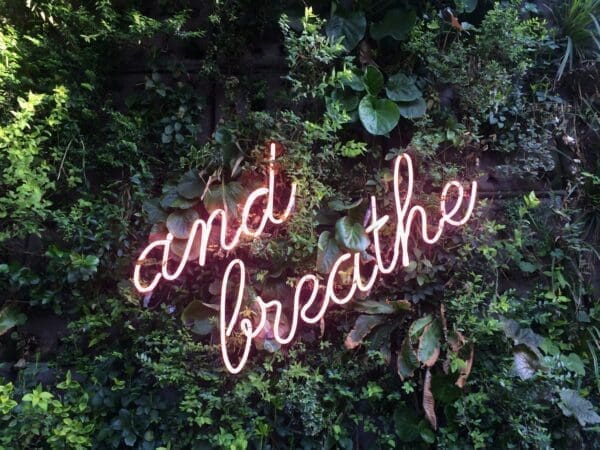Keeping an ‘Open Mind’
Window of tolerance is a therapy term, describing our mental bandwidth available to tolerate stress before it disrupts our performance. Dan Siegel, a clinical professor of psychiatry, coined the ‘window of tolerance’ as a concept to help trauma patients. However, painful memories can be triggered long after we’re well enough to return to work. So it’s important for leaders and managers to understand the window of tolerance and its impact on employees’ performance.
In this article, we look at what the window of tolerance is, and the factors that disrupt it. We explore how to apply soothing and grounding techniques so you return to being calm, focused and fully productive. It’s okay not to be okay, but there are things you can do to help yourself.
Recognise Your Window of Tolerance, and You’ll Manage a Whole Lot Better
The window of tolerance is the zone where we process intense emotional arousal in a healthy way. We function normally and react to stress or anxiety appropriately. When we’re calm, grounded, alert, safe and present, that’s the optimal zone. In this window, we work effectively and relate well to ourselves and others. Outside it, we’re distracted, and not at our best.
Most people can deal with the demands and stress of everyday life without much difficulty. But for those who have experienced trauma, anxiety or other mental illness, it can be difficult to stay in your optimal zone.
Recognising your window of tolerance, the symptoms and their severity is a significant help in recovery. If you have no awareness of this, it’s difficult to self-regulate, because you don’t know what’s happening. But you can work on it. Learning to manage your window of tolerance will enable you to deal better with the demands of life.

A Call for Greater Understanding
This article doesn’t attempt to provide solutions for trauma, anxiety, or other conditions needing professional help. More, it’s a call for leaders and managers to show compassion by giving employees support and understanding.
COVID and working from home have heightened business people’s awareness of the need to look after their employees’ mental health. It’s now on many leaders’ and managers’ agendas that they have a duty of care in this area.
There’s greater awareness of post-traumatic stress disorder, or PTSD, and how it affects the human mind. Many things can affect our mental health, but we’ve been conditioned to repress them. We do this with childhood traumas, bullying parents, and physical and mental abuse. And we grin and bear it as we face people being manipulative and relationship breakdowns. We can be bullied for being different at school and at work. People who stick out get picked on, whether it’s for their gender, race, religion, sexual orientation, gender identity or whatever.
‘Come On, Man Up’

Society expects us to cope and get on with our lives, despite all this. The British joke their way through everything. Past generations kept a stiff upper lip. Parents today still tell their sons that big boys don’t cry. And people on social media tell us we can overcome everything because they did. So we feel added pressure when we find it difficult. Smiling when discussing trauma is a way people minimise their experiences. It communicates the notion that what happened really wasn’t so bad. This is a common strategy trauma survivors use, particularly in an attempt to maintain a connection to the people who were the perpetrators.
For businesses to move forward, everyone needs to be aware of their mental health and how easily it can deteriorate without us realising. Leaders and managers need to make it part of their culture to promote a wider understanding of the window of tolerance. But it’s not just a fuzzy, warm, feel-good tick box. Nor should it be a cue for CEOs to post social media images of them nurturing worn-out employees!
Sticky Learning ® is 7 times more effective than 1-day training courses. Plus, you will get a Chain of Evidence proving your Return on Investment. Discover soft skills training that changes behaviours long term.

How Trauma Affects Our Window of Tolerance
If our mental balance has been affected by adversity, either due to trauma or extreme stress, we end up leaving our normal window of tolerance. When our body reacts defensively, it’s just trying to keep us safe. This is perfectly normal when we’re in unsafe situations. But trauma and extreme stress can create similar responses that remain with us, and kick in long after the event has passed. It doesn’t take much to trigger them, especially if you’re on edge to start with, as happens at work. At some level, your mind thinks the trauma or extreme stress you experienced in the past is happening again.
These trigger factors can include emails, work calls, microaggressions or throwaway comments. Social media interactions can do it. It can also happen with messages reminding you to pay bills. And it can happen with physical intrusions like someone standing too close in a supermarket or on a train. Or, someone parks in our space or sits in our seat. It’s all about managing ourselves and our emotions.
Don’t Tell Someone Buck Up and Deal With it, That isn’t Going to Help
Someone constantly living in their past trauma is primed to detect threats – and enter into that state of defence. That means they have a very narrow window of tolerance. The stress of a traumatic memory or trigger may cause them to be pushed out of it.
‘Are you comfortable with that?’ is a common question when someone puts a proposition to you in a business conversation. But the words will resonate with anyone who’s had to learn to manage their feelings after trauma or anxiety. There are three stages of discomfort.
Dysregulation happens when you begin to deviate outside your window of tolerance. You start to feel agitated or anxious. You don’t feel comfortable, but you’re still in control.
Once you go past this point, your body’s defences start taking over. You experience symptoms like anxiety and feel you are out of control. You may experience Hyperarousal, characterised by excessive activation of energy. Or you experience Hypoarousal when you start to freeze and withdraw.
Hyperarousal
You commonly experience a heightened sense of anxiety. This will make you more sensitive or overly responsive to things in daily life. You have to calm yourself. Try to empathise with the other person, and be compassionate with yourself. You’re okay. Get back into your window of tolerance and do what’s appropriate.

The fight or flight responses happen in the hyperarousal state. These include:
- Anxiety.
- Panic.
- Fear.
- Defensiveness.
- Anger.
- Hypervigilance.
A common condition following trauma or anxiety, hypervigilance is a state of increased alertness. This makes you extremely sensitive to your surroundings. You feel you’re alert to any hidden dangers, whether from other people or the environment. Sometimes hypervigilance is a symptom of an underlying mental health condition, like anxiety or schizophrenia. You need professional help. When you’re navigating conditions that include symptoms of fear, avoidance or extreme stress reactions, you might experience irrational or exaggerated fear about a situation or event. Watch out for that.
Hyperarousal keeps your mind “permanently on.” It makes it difficult to sleep, eat, manage emotions, or, as this is a business article, concentrate on work. If hyperarousal escalates to the most intense level, this may result in dissociative rage and hostility.
Hypoarousal
This is the complete opposite. It’s the result of ‘freeze’ responses, where your mind shuts down in response to trauma. You may experience
- Numbness.
- No feelings.
- Lack of energy.
- Inability to think or respond.
- Reduced physical movement.
- Ashamed.
Hypoarousal can also impact your sleep and eating habits, leaving you feeling emotionally flat. You feel unable to express yourself, process thoughts and emotions and respond physically.
Start to Deal With it by Understanding the Situation
Here are four simple steps to assess your window of tolerance and work out what’s happening:
- Pay attention to your symptoms.
- Identify the symptoms you’re experiencing right now.
- Recognise the severity (the distress level).
- Identify the cause.
So What’s Happening Underneath?
If you’re outside your window of tolerance, your body is wired for defence, and the slightest thing makes you uncomfortable. You’re hypersensitive to any possibility that people are criticising you, or on the attack. Tightness in your chest, stiff shoulders, mild headache and unease in your stomach are tell-tale signs. Learn to recognise these when they’re mild, and head them off by practising and refocusing. And the more you practise, the better you can cope, and gradually increase your window of tolerance.
How Do You Stay Within a Window of Tolerance?
Breathing

A central part of mindfulness, deep breathing can ground you and bring you back to yourself if you’re feeling triggered. Here’s a tip. Breathe in through your nose, hold it for a count of 5, then breathe out through your mouth, and hold it for a count of 5. Repeat it until you feel better.
Physical Activity
Moving around can help shift your energy and regulate your feelings. Try going for a brisk walk, or some other physical activity you enjoy. If you’re working from home, take a break from the laptop and try doing some chores, or maybe cooking.
Soothe Your Senses
When you feel triggered, calm yourself with things you like looking at or touching, smelling, hearing or tasting. “Smell the coffee,” as the saying goes. Better still, think about your favourite things and write them down. What works for you? Is it your favourite music, watching movies, eating your favourite food?
Challenge Your Thoughts
If you have a negative thought, catch it in your mind, and challenge it with a more positive one. Or, step away from the thought! Picture someone standing behind you. Try and visualise that person, looking at the back of your head. Imagine how calm they feel. How would they see this? What would a good friend say? Try to hear a sympathetic voice in your mind, to balance out the critical voice(s) you’re hearing. Have imaginary conversations with yourself. Move around, with ‘worried you’ in one seat and calm you in the other. And show compassion for yourself. Make sure ‘calm you’ is kind to ‘worried you’!
Mindfulness
Stay in the moment. Recognise which specific things are making you feel uncomfortable. What memories are they bringing up? Knowing what triggers you is the first step to managing troubling feelings.
Write Things Down
Make a note of your feelings when you’re stressed or worried. Journaling helps get you into a more settled frame of mind, so you see what’s happening, and feel calmer.
How to Spot When Someone is Feeling Threatened
When people feel threatened, they dissociate, as in disconnecting from their immediate reality. Signs of dissociation can be subtle, like unexpected lapses in attention and momentary avoidance of eye contact. Or, they stare into space. This silly ‘freeze’ response kicks in even when there’s nothing objectively unsafe about the situation or the interpersonal interaction. If you see this happening to someone else, you need to ask if the person is all right.
I Want to Talk to Somebody…
There’s much excellent guidance about all this and many resources online. A sympathetic leader, manager or colleague can help by listening. But the person concerned may feel it best to talk to someone independent, who will be supportive and won’t be judgemental.

Many progressive businesses encourage staff to check in regularly about their mental health and refer them to wellbeing services. The goal for everyone should be autonomy, making them self-sufficient again. And that means grasping the window of tolerance and mastering the techniques and approaches.
And Finally: Emergency Self Help: Be Your Own Client: Have Fun!
Search ‘Window of Tolerance’ online and you’ll find various videos, PDFs and books that leaders, managers and HR people can access, to learn more. Also, for the individuals impacted, there are window of tolerance worksheets you can download as PDF’s, to work on particular areas.
If you’re affected by trauma or anxiety, here are some emergency self-help tips you’ll come across in trauma courses. Soothe yourself with these tested techniques:
Release Your Anger
- Close your eyes and lie down or sit, to relax and calm down.
- Give yourself a 10-second butterfly hug.

- Stretch your arms in front of you and feel the anger drain out.
- Shake your arms and get rid of the stress
Take a drink of water, to cool down. The brain needs water, so stay hydrated.
- Breathe: Inhale through your nose. Hold it for a count of 5. Breathe out through your mouth. Hold it for a count of 5. Repeat it until you are calm.
- Colours: Look for three things around you that are red, then three green things, then three yellow ones. Or whatever colours the things around you are. Repeat this until you feel calm again.
- Make a mental health first aid kit: If you’re finding things difficult, be prepared. Work out what helps you calm down, including physical exercise you enjoy, breathing, listening to music or whatever. Write it down and be aware of it. You could also invest in some herbal stress relief pills.
Be Your Own Client
This idea might particularly appeal to sales, marketing and agency people… Treat your mental health as a client. Monitor your performance, and hold regular reviews. Talk to yourself about it, sitting in different seats. Keep a record of your Key Performance Indicators, and set yourself targets to achieve. And be compassionate with yourself if you don’t hit them!
Last But Not Least, Have Some Fun
Develop hobbies and interests that relax you and help you feel at peace. Self-care is so important. Take time out, and just enjoy yourself.
For more relevant content, check out our article on the Betari Box and see how the window of tolerance also helps with conflict.




